light PEUGEOT 108 2015 Owners Manual
[x] Cancel search | Manufacturer: PEUGEOT, Model Year: 2015, Model line: 108, Model: PEUGEOT 108 2015Pages: 271, PDF Size: 7.42 MB
Page 4 of 271
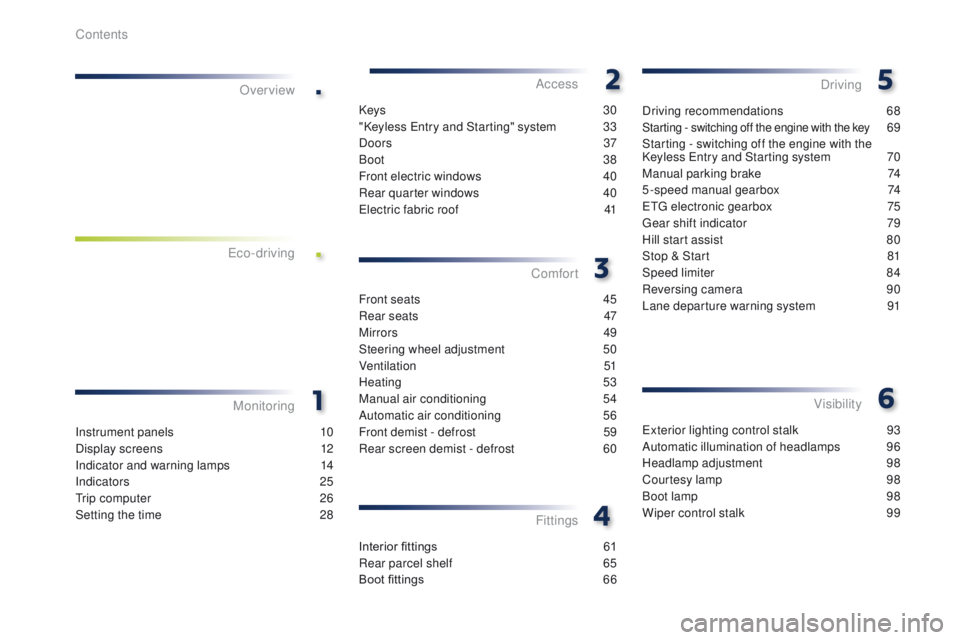
.
.
108_en_Chap00a_sommaire_ed01-2015
exterior lighting control stalk 93
A utomatic illumination of headlamps
9
6
Headlamp adjustment
9
8
Courtesy lamp
9
8
Boot lamp
9
8
Wiper control stalk
9
9
Visibility
Instrument panels 1 0
Display screens
1
2
Indicator and warning lamps
1
4
Indicators
25
tr
ip computer
2
6
Setting the time
2
8
MonitoringOver view
Keys
30
"Keyless e
n
try and Starting" system
3
3
Doors
37
Boo
t
38
Front electric windows
4
0
Rear quarter windows
4
0
ele
ctric fabric roof
4
1
Access
Front seats 4 5
Rear seats
4
7
Mirrors
4
9
Steering wheel adjustment
5
0
Ventilation
5
1
Heating
53
Manual air conditioning
5
4
Automatic air conditioning
5
6
Front demist - defrost
5
9
Rear screen demist - defrost
6
0
Comfort
Interior fittings 61
Rear parcel shelf
6
5
Boot fittings
6
6
Fittings
Driving recommendations 68
Starting - switching off the engine with the key 69
Starting - switching off the engine with the
Keyless
e
n
try and Starting system
7
0
Manual parking brake
7
4
5-speed manual gearbox
7
4
e
tg
el
ectronic gearbox
7
5
ge
ar shift indicator
7
9
Hill start assist
8
0
Stop & Start
8
1
Speed limiter
8
4
Reversing camera
9
0
Lane departure warning system
9
1
Driving
e
co-driving
Contents
Page 6 of 271
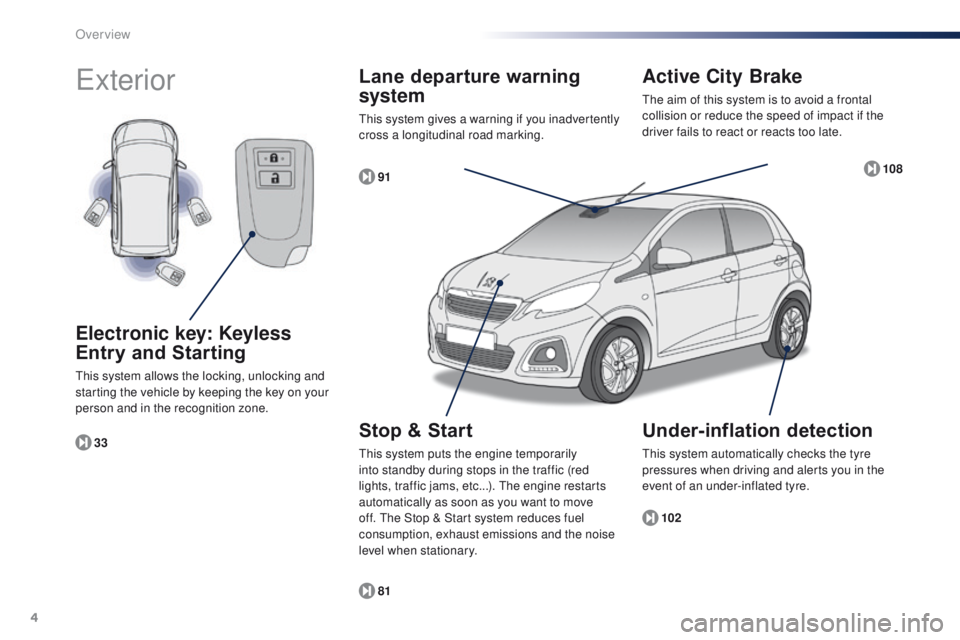
4
108_en_Chap00b_vue-ensemble_ed01-2015
exterior
102
81 91
33
Electronic key: Keyless
Entry and Starting
this system allows the locking, unlocking and
starting the vehicle by keeping the key on your
person and in the recognition zone.
Stop & Start
this system puts the engine temporarily
into standby during stops in the traffic (red
lights, traffic jams, etc...). t
h
e engine restarts
automatically as soon as you want to move
off.
t
h
e Stop & Start system reduces fuel
consumption, exhaust emissions and the noise
level when stationary.
Under-inflation detection
this system automatically checks the tyre
pressures when driving and alerts you in the
event of an under-inflated tyre.
Active City Brake
the aim of this system is to avoid a frontal
collision or reduce the speed of impact if the
driver fails to react or reacts too late.
Lane departure warning
system
this system gives a warning if you inadvertently
cross a longitudinal road marking.
108
Over view
Page 9 of 271
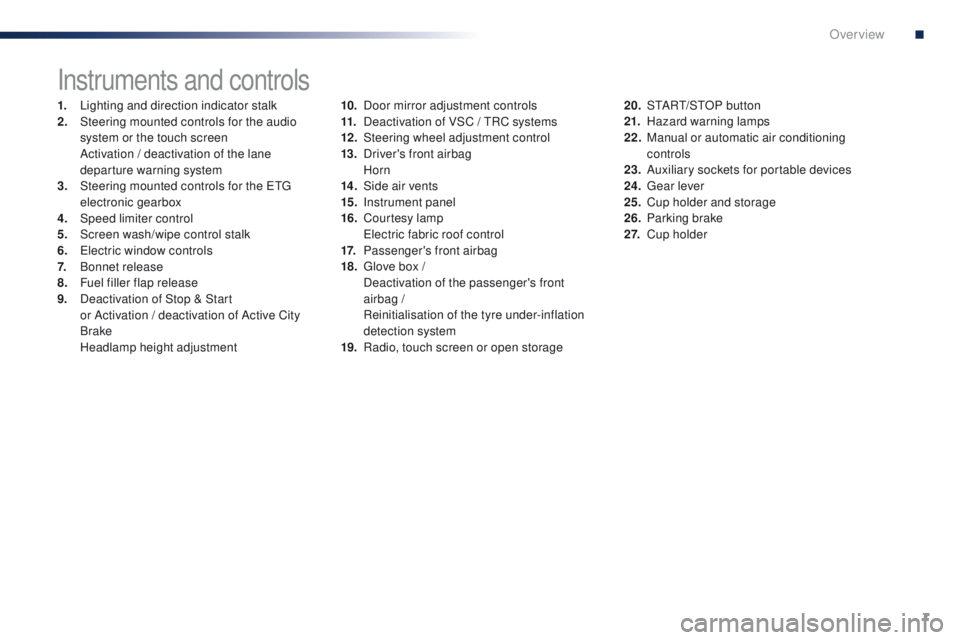
7
108_en_Chap00b_vue-ensemble_ed01-2015
Instruments and controls
1. Lighting and direction indicator stalk
2. Steering mounted controls for the audio
system or the touch screen
A
ctivation / deactivation of the lane
departure warning system
3.
S
teering mounted controls for the etg
electronic gearbox
4.
Spe
ed limiter control
5.
S
creen wash/wipe control stalk
6.
e
le
ctric window controls
7.
B
onnet release
8.
F
uel filler flap release
9.
D
eactivation of Stop & Start
or
Activation / deactivation of Active City
Brake
H
eadlamp height adjustment 10. D
oor mirror adjustment controls
11. D eactivation of VSC / tR C systems
12 .
S
teering wheel adjustment control
13.
D
river's front airbag
Horn
14 .
S
ide air vents
15.
I
nstrument panel
16.
C
ourtesy lamp
e
le
ctric fabric roof control
17.
P
assenger's front airbag
18.
g
l
ove box /
D
eactivation of the passenger's front
airbag /
R
einitialisation of the tyre under-inflation
detection system
19.
R
adio, touch screen or open storage20. S
tA Rt/ S tO P button
21. H azard warning lamps
22.
M
anual or automatic air conditioning
controls
23.
A
uxiliary sockets for portable devices
24.
g
ea
r lever
25.
C
up holder and storage
26.
P
arking brake
2 7.
C
up holder
.
Over view
Page 10 of 271
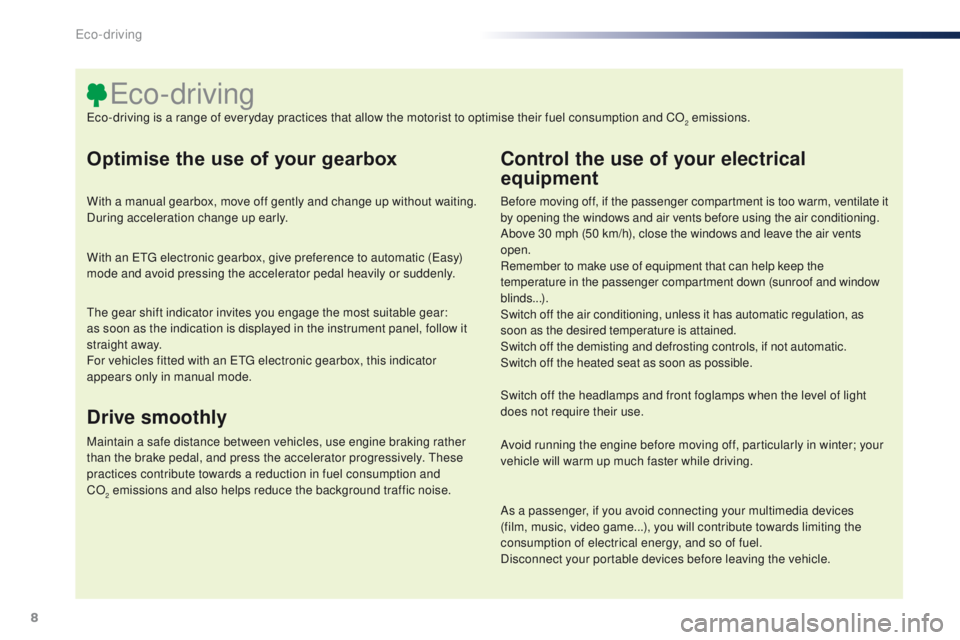
8
108_en_Chap00c_eco-conduite_ed01-2015
Optimise the use of your gearbox
With a manual gearbox, move off gently and change up without waiting.
During acceleration change up early.
With an etg electronic gearbox, give preference to automatic (
ea
sy)
mode and avoid pressing the accelerator pedal heavily or suddenly.
Control the use of your electrical
equipment
Before moving off, if the passenger compartment is too warm, ventilate it
by opening the windows and air vents before using the air conditioning.
Above 30 mph (50 km/h), close the windows and leave the air vents
open.
Remember to make use of equipment that can help keep the
temperature in the passenger compartment down (sunroof and window
blinds...).
Switch off the air conditioning, unless it has automatic regulation, as
soon as the desired temperature is attained.
Switch off the demisting and defrosting controls, if not automatic.
Switch off the heated seat as soon as possible.
Switch off the headlamps and front foglamps when the level of light
does not require their use.
Avoid running the engine before moving off, particularly in winter; your
vehicle will warm up much faster while driving.
As a passenger, if you avoid connecting your multimedia devices
(film, music, video game...), you will contribute towards limiting the
consumption of electrical energy, and so of fuel.
Disconnect your portable devices before leaving the vehicle.
eco-driving
eco-driving is a range of everyday practices that allow the motorist to optimise their fuel consumption and CO2 emissions.
th
e gear shift indicator invites you engage the most suitable gear:
as
soon as the indication is displayed in the instrument panel, follow it
straight away.
For vehicles fitted with an
etg
electronic gearbox, this indicator
appears only in manual mode.
Drive smoothly
Maintain a safe distance between vehicles, use engine braking rather
than the brake pedal, and press the accelerator progressively. th ese
practices contribute towards a reduction in fuel consumption and
CO
2 emissions and also helps reduce the background traffic noise.
eco-driving
Page 21 of 271
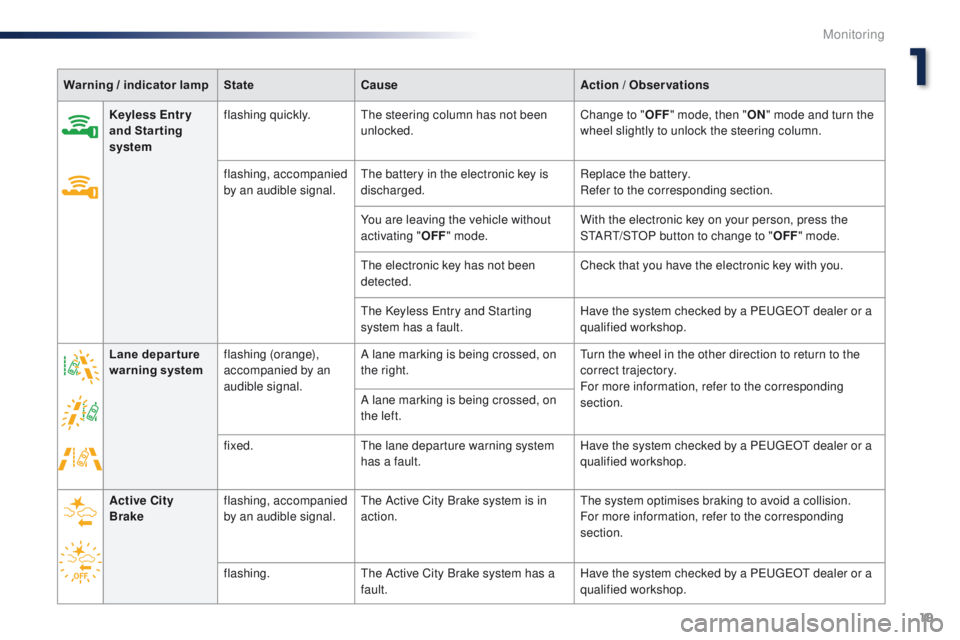
19
108_en_Chap01_controle-de-marche_ed01-2015
Warning / indicator lampStateCause Action / Observations
Keyless Entr y
and Starting
system flashing quickly.
th
e steering column has not been
unlocked. Change to "
OFF" mode, then " ON" mode and turn the
wheel slightly to unlock the steering column.
flashing, accompanied
by an audible signal.
th
e battery in the electronic key is
discharged. Replace the battery.
Refer to the corresponding section.
You are leaving the vehicle without
activating " OFF" mode. With the electronic key on your person, press the
S
tA
R
t/
S
tO
P button to change to "OFF" mode.
th
e electronic key has not been
detected. Check that you have the electronic key with you.
th
e Keyless e
n
try and Starting
system has a fault. Have the system checked by a P
e
uge
Ot
dealer or a
qualified workshop.
Lane depar ture
warning system flashing (orange),
accompanied by an
audible signal. A lane marking is being crossed, on
the right.
tu
rn the wheel in the other direction to return to the
correct trajectory.
For more information, refer to the corresponding
section.
A lane marking is being crossed, on
the left.
fixed.
th
e lane departure warning system
has a fault. Have the system checked by a P
e
uge
Ot
dealer or a
qualified workshop.
Active City
Brake flashing, accompanied
by an audible signal.
th
e Active City Brake system is in
action.
th
e system optimises braking to avoid a collision.
For more information, refer to the corresponding
section.
flashing.
th
e Active City Brake system has a
fault. Have the system checked by a P
e
uge
Ot
dealer or a
qualified workshop.
1
Monitoring
Page 22 of 271
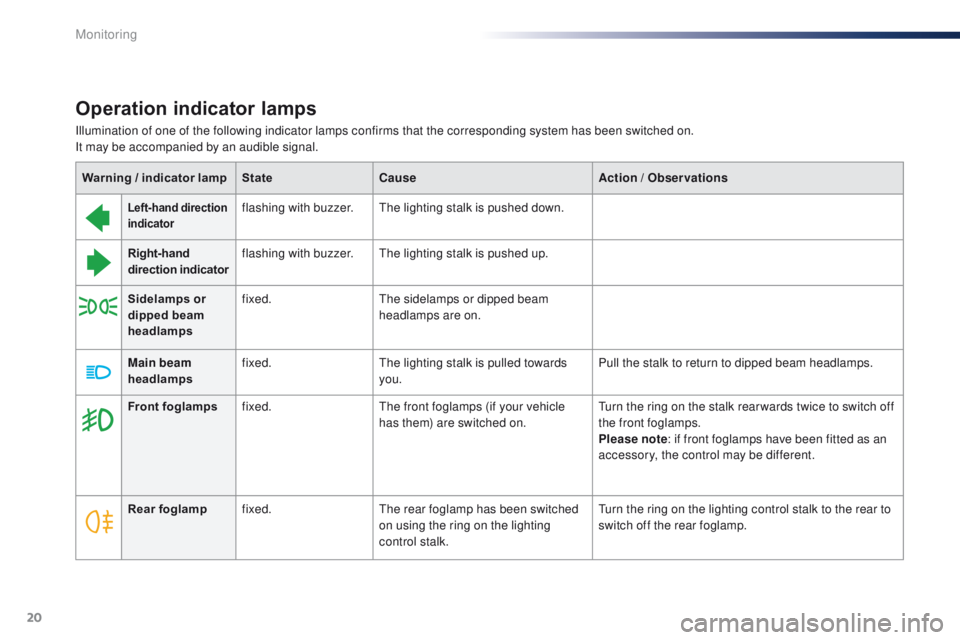
20
Operation indicator lamps
Left-hand direction
indicatorflashing with buzzer.th e lighting stalk is pushed down.
Right-hand
direction indicator flashing with buzzer.
th
e lighting stalk is pushed up.
Sidelamps or
dipped beam
headlamps fixed.
th
e sidelamps or dipped beam
headlamps are on.
Main beam
headlamps fixed.
th
e lighting stalk is pulled towards
you. Pull the stalk to return to dipped beam headlamps.
Warning / indicator lamp
StateCause Action / Observations
Illumination of one of the following indicator lamps confirms that the corresponding system has been switched on.
It may be accompanied by an audible signal.
Rear foglamp fixed.
th
e rear foglamp has been switched
on using the ring on the lighting
control stalk.
tu
rn the ring on the lighting control stalk to the rear to
switch off the rear foglamp.
Front foglamps
fixed.
th
e front foglamps (if your vehicle
has them) are switched on.
tu
rn the ring on the stalk rear wards twice to switch off
the front foglamps.
Please note : if front foglamps have been fitted as an
accessory, the control may be different.
Monitoring
Page 23 of 271
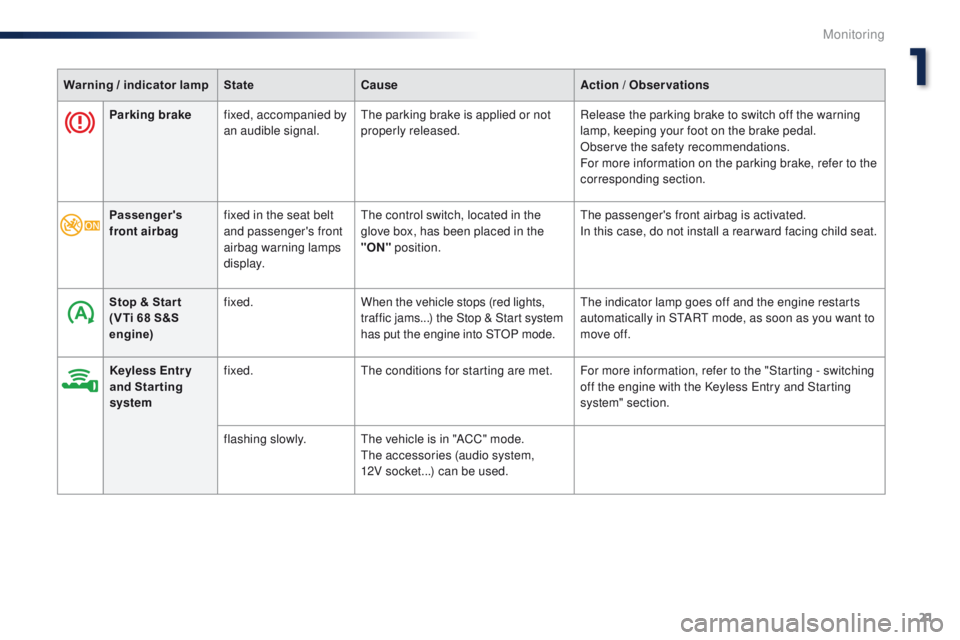
21
108_en_Chap01_controle-de-marche_ed01-2015
Parking brakefixed, accompanied by
an audible signal.th e parking brake is applied or not
properly released. Release the parking brake to switch off the warning
lamp, keeping your foot on the brake pedal.
Observe the safety recommendations.
For more information on the parking brake, refer to the
corresponding section.
Warning / indicator lamp
StateCause Action / Observations
Passenger's
front airbag fixed in the seat belt
and passenger's front
airbag warning lamps
display.
th
e control switch, located in the
glove box, has been placed in the
"ON" position.
the
passenger's front airbag is activated.
In this case, do not install a rear ward facing child seat.
Stop & Star t
(VTi 68 S&S
engine) fixed.
When the vehicle stops (red lights,
traffic jams...) the Stop & Start system
has put the engine into S
tO
P mode.
th
e indicator lamp goes off and the engine restarts
automatically in S
tA
R
t
mode, as soon as you want to
move off.
Keyless Entr y
and Starting
system fixed.
th
e conditions for starting are met. For more information, refer to the "Starting - switching off the engine with the Keyless
e
n
try and Starting
system" section.
flashing slowly.
th
e vehicle is in "ACC" mode.
th
e accessories (audio system,
12V socket...) can be used.
1
Monitoring
Page 28 of 271

26
tr i p c o m p u t e r
System that gives you information on the journey in progress (range, fuel consumption…).
Information display
F Press one of theses buttons to display the various trip computer tabs in turn:
-
t
h
e total distance.
-
t
h
e trip "A".
-
t
h
e trip "B" .
-
t
h
e Stop & Start partial time counter*.
-
t
h
eStop & Start global time counter*.
-
t
h
e ambient temperature*.
-
t
h
e current fuel consumption.
-
t
h
e average fuel consumption.
-
t
he
remaining range.
-
t
h
e average speed.
-
t
h
e lighting dimmer.
Trip reset
F When the trip required is displayed, press one of the two buttons for more than
two
seconds.
t
r i p s "A" and "B" are independent but their
use is identical.
For example, trip "A" can be used for daily
figures, and trip "B" for monthly figures.
* Depending on version.
Lighting dimmer
When driving at night, this function allows
certain displays in the instrument panel to be
switched off to reduce visual fatigue for the
driver.
It operates only when the sidelamps are on.
F
W
hen the "Lighting dimmer" menu is
displayed, press and hold one of the
buttons for access to the adjustment.
F
t
h
en make repeated presses on one of
the two buttons to increase or reduce the
brightness.
t
h
e display flashes to show you the
brightness chosen.
Monitoring
Page 33 of 271
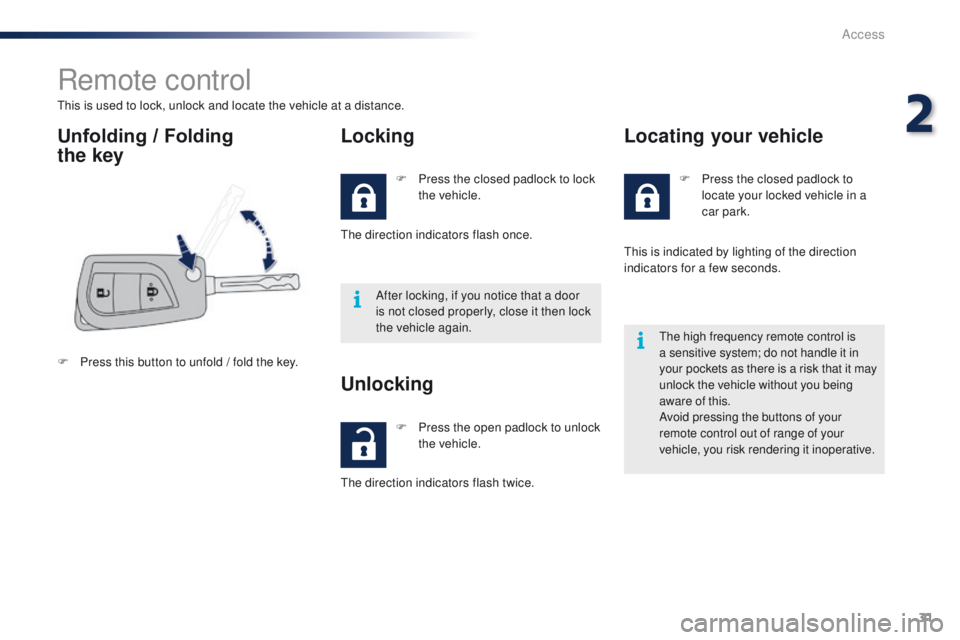
31
108_en_Chap02_ouvertures_ed01-2015
Remote control
this is used to lock, unlock and locate the vehicle at a distance.
Unfolding / Folding
the key Locking
F Press this button to unfold / fold the key. F
P
ress the closed padlock to lock
the vehicle.
th
e direction indicators flash once.
After locking, if you notice that a door
is not closed properly, close it then lock
the vehicle again.
F
P
ress the open padlock to unlock
the vehicle.
Unlocking
the direction indicators flash twice. F
P
ress the closed padlock to
locate your locked vehicle in a
car park.
Locating your vehicle
this is indicated by lighting of the direction
indicators for a few seconds.
th
e high frequency remote control is
a sensitive system; do not handle it in
your pockets as there is a risk that it may
unlock the vehicle without you being
aware of this.
Avoid pressing the buttons of your
remote control out of range of your
vehicle, you risk rendering it inoperative.
2
Access
Page 50 of 271
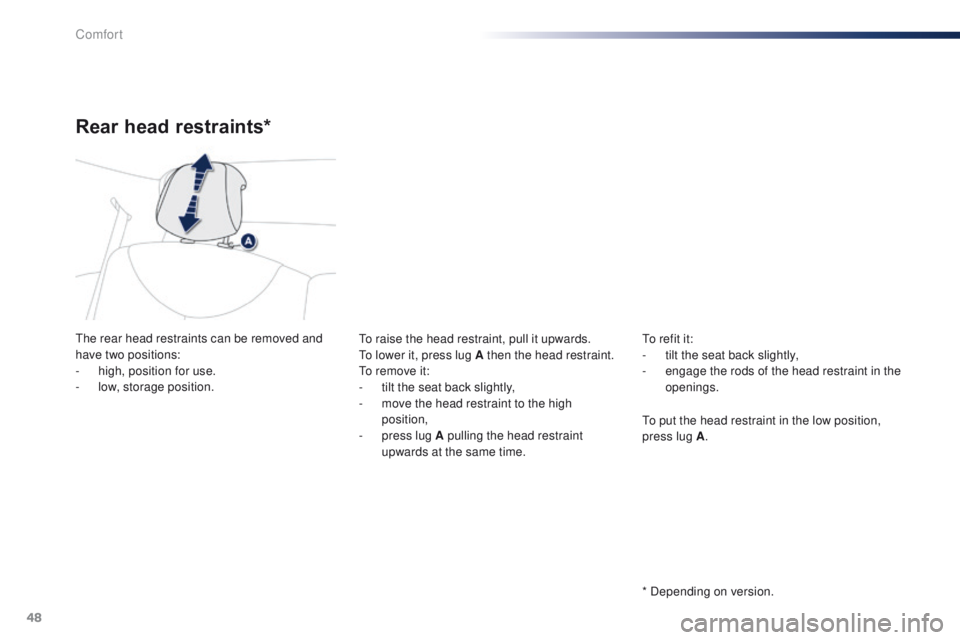
48
108_en_Chap03_confort_ed01-2015
Rear head restraints*
the rear head restraints can be removed and
have two positions:
-
h
igh, position for use.
-
lo
w, storage position.to r aise the head restraint, pull it upwards.
to l
ower it, press lug A then the head restraint.
to r
emove it:
-
t
ilt the seat back slightly,
-
m
ove the head restraint to the high
position,
-
p
ress lug A pulling the head restraint
upwards at the same time.to refit it:
-
t
ilt the seat back slightly,
-
e
ngage the rods of the head restraint in the
openings.
* Depending on version.
to p
ut the head restraint in the low position,
press lug A .
Comfort